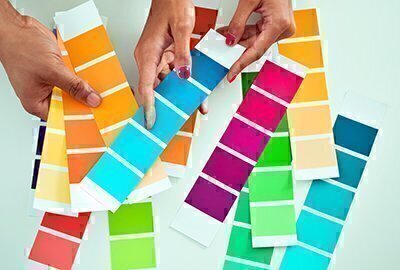Swatch Your Step: How to Pick Paint Colors
Last updated June 2021
Visit any paint store, and it’s easy to get overwhelmed by the rainbow coalition of colors—dark-as-the-Aegean navy, pale pink that seems inspired by morning mist (or maybe ballet shoes), even bold black. Most paint manufacturers produce hues by the thousands, not dozens (Benjamin Moore alone sells more than 3,500 shades). So when you’re redoing a room—or spiffing up the exterior of your house—how do you choose?
 Devise a Color Scheme
Devise a Color Scheme
Before you head to the store, come up with a color scheme for the room or project you’re tackling. If you’re repainting to set off that new floral sofa, riff on it by drawing out one shade from the print. A whole-house coating can play off of trees in your front yard or be inspired by historic hues. A color wheel—either a small one you pick up at a paint or art store, or an online one—can help you with this, too, since it decodes what shades play nicely together.
Take It Home
Don’t choose your paint color in the store. Take home samples (the bigger the better), and look at them in the space or place you’ll be using the paint. Many companies offer tiny pots of paint or laptop-sized stick-on swatches these days, too.
Slap Up a Little
That weensy strip of shades from the paint store isn’t big enough to help you find the ideal color; you’re going to need to spring for a pint of paint or a larger color card (now available from manufacturers including Benjamin Moore, Farrow & Ball, Sherwin-Williams, and most other major players) in each color you’re pondering.
Paint a small area of wall—say two feet by two feet—in each of the colors. Or apply the shades to pieces of poster board and pin them to the wall. Then keep an eye on how that Kelly green or moody mauve looks at different times of the day, in different lights, and indoors, with your sofa/chair/collection of Rembrandt prints.
Go for Some Flow
When painting interiors, many wannabe HGTV stars go rainbow wild, making one room peach, an adjoining room red, etc. Yes, color is a highly subjective choice—one person’s dream disco-den gold is another person’s too-bright nightmare. But if you tie in some colors or shades throughout your home, you’ll create a more cohesive, more soothing look. Bonus: Painting adjoining rooms in similar or coordinating shades can make your whole pad look bigger.
Call in a Pro
Many paint stores employ color consultants who, for a small fee (usually around $100), will come to your house and help you choose paint. Interior designers also often offer this service. Yep, you might balk at paying someone to make your choices, but these experts—who usually know a lot about color theory and which paints work best in dark or light spaces—can winnow in on your style and needs quickly.


